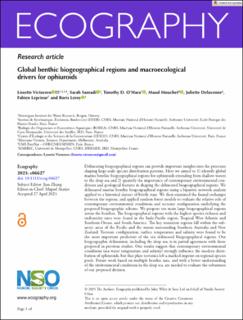| dc.contributor.author | Gonzalez, Lissette Victorero | |
| dc.contributor.author | Samadi, Sarah | |
| dc.contributor.author | O'Hara, Timothy D. | |
| dc.contributor.author | Mouchet, Maud | |
| dc.contributor.author | Delavenne, Juliette | |
| dc.contributor.author | Leprieur, Fabien | |
| dc.contributor.author | Leroy, Boris | |
| dc.date.accessioned | 2024-01-25T08:39:34Z | |
| dc.date.available | 2024-01-25T08:39:34Z | |
| dc.date.created | 2023-08-18T12:29:56Z | |
| dc.date.issued | 2023 | |
| dc.identifier.citation | Ecography. 2023, 2023 (9), e06627. | en_US |
| dc.identifier.issn | 0906-7590 | |
| dc.identifier.uri | https://hdl.handle.net/11250/3113700 | |
| dc.description.abstract | Delineating biogeographical regions can provide important insights into the processes shaping large-scale species distribution patterns. Here we aimed to 1) identify global marine benthic biogeographical regions for ophiuroids extending from shallow waters to the deep sea and 2) quantify the importance of contemporary environmental conditions and geological features in shaping the delineated biogeographical regions. We delineated marine benthic biogeographical regions using a bipartite network analysis applied to a historical dataset of brittle stars. We then examined the faunal exchanges between the regions, and applied random forest models to evaluate the relative role of contemporary environmental conditions and tectonic configuration underlying the proposed biogeographic scheme. We propose ten main large biogeographical regions across the benthos. The biogeographical regions with the highest species richness and endemicity rates were found in the Indo-Pacific region, Tropical West Atlantic and Southern Ocean, and South America. The key transition regions fall within the subarctic areas of the Pacific and the waters surrounding Southern Australia and New Zealand. Tectonic configuration, surface temperature and salinity were found to be the most important predictors of the ten delineated biogeographical regions. Our biogeographic delineation, including the deep sea, is in partial agreement with those proposed in previous studies. Our results suggest that contemporary environmental conditions (sea water temperature and salinity) strongly influence the modern distribution of ophiuroids, but that plate tectonics left a marked imprint on regional species pools. Future work based on multiple benthic taxa, and with a better understanding of the environmental conditions in the deep sea, are needed to evaluate the robustness of our proposed division. | en_US |
| dc.language.iso | eng | en_US |
| dc.publisher | Wiley | en_US |
| dc.rights | Navngivelse 4.0 Internasjonal | * |
| dc.rights.uri | http://creativecommons.org/licenses/by/4.0/deed.no | * |
| dc.title | Global benthic biogeographical regions and macroecological drivers for ophiuroids | en_US |
| dc.type | Peer reviewed | en_US |
| dc.type | Journal article | en_US |
| dc.description.version | publishedVersion | en_US |
| dc.rights.holder | © 2023 The Authors | en_US |
| dc.source.pagenumber | 15 | en_US |
| dc.source.volume | 2023 | en_US |
| dc.source.journal | Ecography | en_US |
| dc.source.issue | 9 | en_US |
| dc.identifier.doi | 10.1111/ecog.06627 | |
| dc.identifier.cristin | 2167961 | |
| dc.source.articlenumber | e06627 | en_US |
| cristin.ispublished | true | |
| cristin.fulltext | original | |
| cristin.qualitycode | 2 | |

